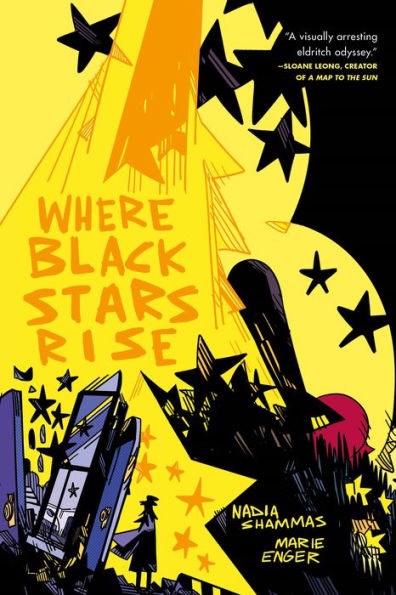
Where Black Stars Rise

The King in Yellow by Robert W. Chambers has had a storied influence on the arts. In the 2014 first season of HBO’s True Detective, for example, there are references to the work and H.P. Lovecraft made passing allusions to it in the story “The Whisperer in Darkness.” Music has been composed in reverence. And to make things ultra-meta, The King in Yellow is also the name of the play which is referred to in some of the ten stories that comprise the eponymous book. In the graphic novel Where Black Stars Rise, writer Nadia Shammas and creator Marie Enger seize upon the meta element, expounding on it and expanding the possibilities. The title itself is inspired by a stanza from Act 1, Scene 2, of the fictional play. It’s another convergence of cosmic horror and the consciously self-referential: A mimicry of a conceit that Chambers employed which also serves as a tribute to the author. Whew. Happily, the complexities involved in the narrative are handled with aplomb, making Where Black Stars Rise an intriguing and eye-catching graphic novel.
The plot concerns two immigrant females. Lebanese Dr. Amal Robardin, a therapist-in-training and her patient Yasmin Mofid who hailed from Iran. Both have families in their respective countries and are finding that the ties that bind know no bounds of distance. Yasmin, who has been diagnosed as schizophrenic, discovers some respite from her illness through interest in a Brooklyn theatre group that performs experimental plays. And although she initially bonds with the therapist, Dr. Amal’s own unresolved issues and self-doubt eventually become obstacles within their sessions. After Yasmin abandons therapy, Amal goes on a quest to find her patient. Which leads her to the theatre where, you guessed it, The King in Yellow is on the bill.

There is a palpable poignancy about Yasmin that is revealed through her blog, in which she expresses why she relates to horror fiction in general and The King in Yellow, in particular: “Despite the deeply racist and misogynistic roots of these works, primarily the violent xenophobia of its creators, there’s an existential understanding as to what it feels like to be powerless. While these men grappled with the horror of an uncaring universe, marginalized individuals grapple with the horror of a system specifically designed not to care about us. We are born into something larger, something malevolent, something we have no power to stop. Similarly, in The King in Yellow itself, there is no reason why our unfortunate narrators are chosen.”
While cynical readers will no doubt pronounce this as “woke,” and indeed many of the prescribed boxes (immigrants, people of color, disenfranchisement, lesbian cohabitation) do get checked in this graphic novel. But even hardcore cynics would find it difficult not to appreciate the Nightfire Book Where Black Stars Rise. It will appeal to those who admire Victor LaValle’s extraordinary The Ballad of Black Tom and those who seek The Yellow Sign.

